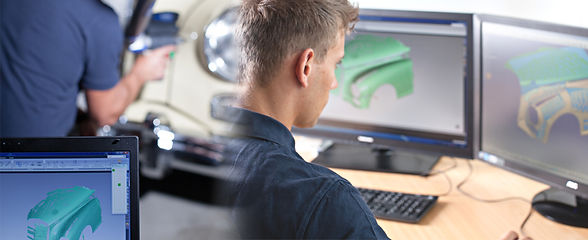
REVERSE ENGINEERING
For us, the digitized component represents the basis of re-engineering.
Through a CAD-supported surface redesign of the digitized grid lines (3D scan in STL format), our engineers transform them into CAD data sets suitable for production .
REVERSE ENGINEERING PROCESS
Depending on the application, either a pure surface model or a parametric solid model is required.
Therefore, there are two options for re-engineering:
VERSION 1: CAD REDESIGN (rebuild)
GENERAL
Our engineers redesign the component in CAD – the parametric surface redesign.
The 3D scan (STL) only serves as a template.
The resulting volume model (STEP) can be edited in any CAD software. Alternatively, we also offer a parametric model with a history in the CAD program of your choice.
APPLICATION CASE
-
Parametric model
-
Volume model | Solid | part
-
FE Analysis
-
3D printing
-
CNC milling
PROCESS
-
3D scan serves as a template / reference for the newly built model
-
CAD model is built from basic geometric shapes (points, lines, circles) ("solid modeling")
-
Component features such as dividing lines, draft angles and fillets are stored in the construction tree
-
Measured values from the scan (eg odd hole dimensions, flat surfaces etc.) are interpreted meaningfully
RESULT
Parametric, associative CAD model with mathematically correct, qualitatively perfect surfaces.
BENEFITS
-
Editable CAD volume model including construction history ("construction tree")
-
Component can be optimized / changed / further developed
-
CAD data in connection with 2D drawing derivation optimal for component production
DISADVANTAGE
-
Deviation from 3D scan due to new construction can - depending on the application - be greater than with AutoSurface (approx. 0.1 - 0.25 mm); no functional impairment
-
Redesign, especially with free-form surfaces, is sometimes very time-consuming

3D SCAN
Polygon mesh / facet model (STL)
3D surface scan of the original component.

CAD MODEL
Parametric surface model
Native, redesigned surface model in CAD. Qualitatively perfect surfaces with wall thickness.

COMPARISON
Functional component
Slight deviations between 3D scan and Auto Surface.
VERSION 2: AUTOMATIC SURFACE REDESIGN
GENERAL
This surface return is an automatic impression of the underlying 3D scan (STL). An algorithm calculates the NURBs surface model (STEP).
APPLICATION CASE
-
Surface model, 3D printing feasible, CNC milling
PROCESS
-
The 3D scan (STL) is loaded into the reverse engineering software.
-
The number of NURBs areas is determined from which the resulting area model (STEP) is to be built.
-
The reverse engineering software creates a direct impression.
-
The holes in the network are closed manually.
RESULT
Non-native CAD model with precise but qualitatively moderate surfaces.
The deviations from the 3D scan (STL) range from 0.01mm to 0.05mm. This surface model is only suitable for organic shapes without edges and holes.
BENEFITS
-
Very little deviation from 3D scan (+/- 0.01 - 0.10 mm)
-
Faster, less expensive automation for organic shapes without edges and holes
DISADVANTAGE
-
Very fine-meshed, large STEP files that can cause problems when used again
-
Many surface defects / holes that may have to be filled manually
-
Therefore CAD post-construction is often faster and cleaner
-
No native data available
-
AutoSurface takes over errors in the 3D scan

3D SCAN
Polygon mesh / facet model (STL)
3D surface scan of the original component.

AUTO SURFACE
NURBs surface model (STEP)
Non-native CAD model thanks to automatic surface return. Qualitatively moderate surfaces.
No wall thickness.

COMPARISON
Functional component
Slight deviations between 3D scan and Auto Surface.
CONCLUSION
MANUAL CAD REDESIGN VS. AUTOMATIC REDESIGN
We recommend – especially with functional components – the manual CAD redesign option.
Reason: Only with this process, smooth production and perfect component function can be ensured .

3D SCAN
Polygon mesh / facet model (STL)
3D surface scan of the original component.

CAD MODEL
Parametric surface model
Native, redesigned surface model in CAD. Qualitatively perfect surfaces with wall thickness.

REPRODUCED COMPONENT
Functional component
Smooth production and perfect component function from a CAD data set.



